Gazebos have become a popular addition to outdoor spaces, providing shade, shelter, and a cozy ambiance for gatherings.
However, as thunderstorms roll in, concerns arise about the safety of gazebos during lightning strikes.
So, are gazebos safe in lightning?
Understanding the potential risks and safety measures can help outdoor enthusiasts make informed decisions to protect themselves.
In this guide, we will explore the science behind lightning strikes, the risks associated with gazebos, and important safety precautions to ensure your outdoor activities remain safe during thunderstorms.
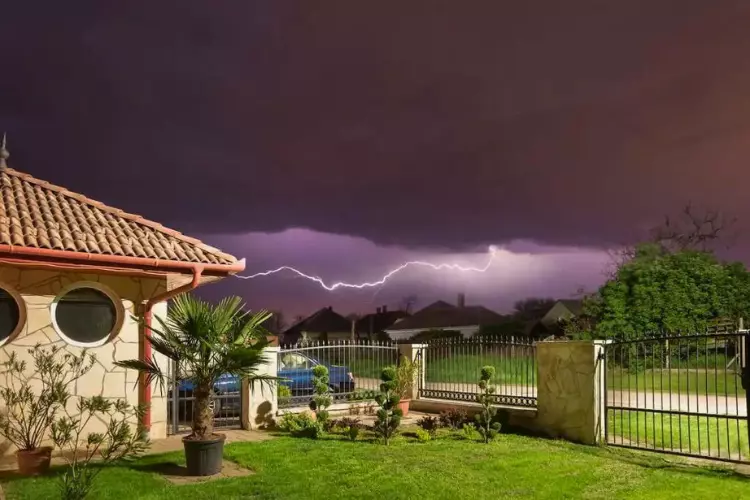
Contents
- 1 Are Gazebos Safe in Lightning?
- 2 How Lightning Behaves?
- 3 Risks of Lightning Strikes
- 4 Factors that Affect Gazebo Safety
- 5 Safety Precautions for Gazebos in Lightning Storms
- 6 What is the safest place to be outside during a lightning storm?
- 7 Safety Tips for Outdoor Activities
- 8 Frequently Asked Questions (FAQs)
- 8.1 Can a gazebo provide sufficient shelter during lightning storms?
- 8.2 What are the best materials for lightning-resistant gazebos?
- 8.3 Is grounding a gazebo essential for safety during thunderstorms?
- 8.4 Are there any additional safety measures to consider when using a gazebo in lightning-prone areas?
- 8.5 Choosing the Right Gazebo for Lightning Safety
Are Gazebos Safe in Lightning?
Gazebos are not completely safe during lightning storms. While they can provide some protection compared to being fully exposed, the risk of lightning strikes remains.
Factors such as gazebo materials and location contribute to the level of safety.
Metal gazebos attract lightning strikes due to their conductivity, while wood gazebos offer better insulation if they lack metal components. Proper grounding is crucial for reducing electrical shock risks.
Seeking shelter indoors is always the safest option during thunderstorms. Hardtop gazebos made of solid materials can provide some protection, but open or makeshift structures like pop-up canopies should be avoided.
It is important to be aware of lightning safety protocols, such as the “30-30 Rule,” and to have an emergency action plan in lightning-prone areas.
Ultimately, prioritizing personal safety and making informed decisions are vital when considering gazebo safety during lightning.
How Lightning Behaves?
Before diving into the topic of gazebo safety, it’s crucial to have a basic understanding of how lightning behaves.
Lightning is a discharge of electricity that occurs between different regions of a storm cloud or between the cloud and the ground. It is estimated that there are about 100 lightning strikes every second globally.
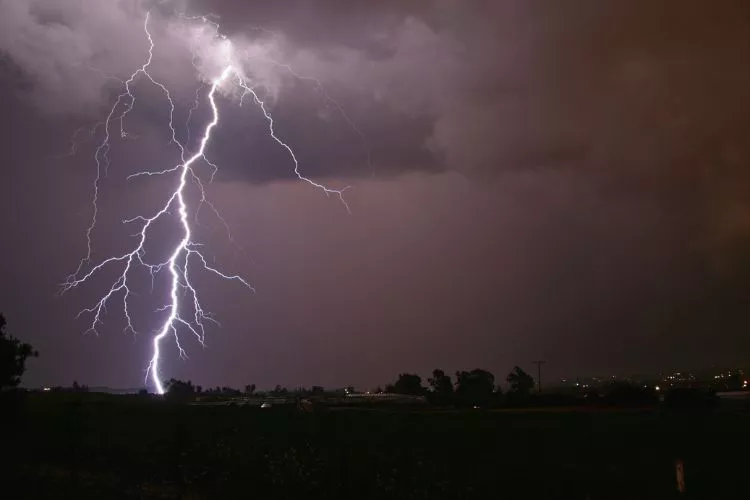
During a thunderstorm, the interaction of air currents within a cloud separates positive and negative charges, resulting in the buildup of electrical energy.
When the difference in charge becomes significant enough, a lightning strike occurs to neutralize the imbalance. Lightning can strike from the cloud to the ground, from the ground to the cloud, or from one cloud to another.
Risks of Lightning Strikes
Lightning strikes pose immense risks to anyone outdoors during a thunderstorm. The main direct effects of lightning on humans include electrocution, thermal burns, and injuries caused by explosive shock waves.
According to the National Weather Service, around 20% of lightning strike victims suffer fatal injuries. Moreover, lightning can also cause fires and damage to structures.
This raises concerns about the safety of gazebos, which often consist of materials that conduct electricity, such as metal or wood with metal components. Let’s take a closer look at the factors that affect gazebo safety during thunderstorms.
Factors that Affect Gazebo Safety
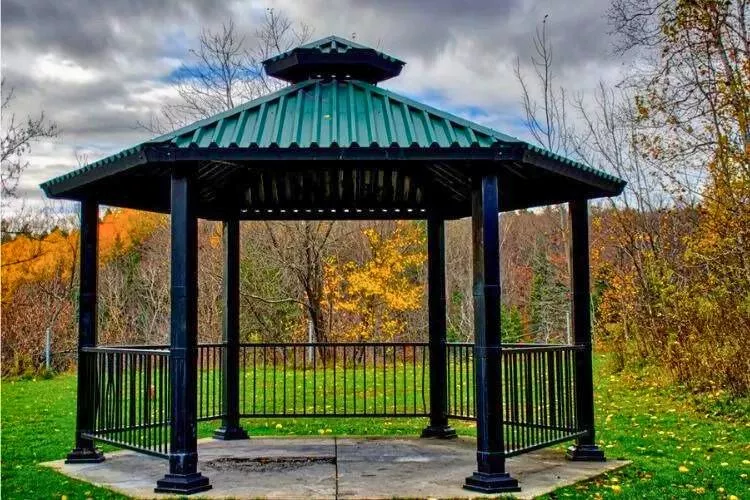
Gazebo Materials and Conductivity
Gazebos are commonly constructed using materials like wood, metal, or a combination of both. Metal gazebos, especially those with a metallic framework, can be conductive and potentially attract lightning strikes.
Wood, on the other hand, is a better insulator but can still pose risks if it contains metal components or is not properly grounded.
Gazebo Location
The location of a gazebo plays a significant role in determining its vulnerability to lightning strikes.
Gazebos situated in open areas, on hilltops, or near tall structures may be at a higher risk because lightning tends to strike the highest point in an area.
Safety Precautions for Gazebos in Lightning Storms
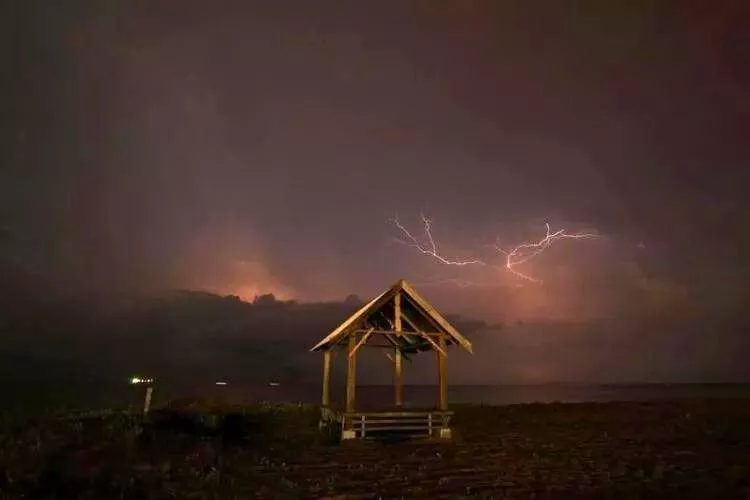
Seek Proper Shelter
The safest option during a thunderstorm is to seek shelter indoors. However, if there is no nearby building available, a hardtop gazebo with a roof made of solid materials like metal or shingles can offer some protection against lightning. Avoid open or makeshift structures like pop-up canopies during storms.
Lightning Safety Protocol
Familiarize yourself with lightning safety protocols, such as the “30-30 Rule.” If you see lightning and hear thunder within 30 seconds of each other, it’s time to seek shelter and wait for at least 30 minutes after the last clap of thunder before resuming outdoor activities.
Grounding the Gazebo
Properly grounding a gazebo can reduce the risk of electrical shock during a lightning storm. Consult a professional electrician to ensure the gazebo is grounded correctly, especially if it has metal components.
What is the safest place to be outside during a lightning storm?
When a lightning storm strikes, being outdoors can be dangerous. Finding the safest place to take shelter is crucial in minimizing the risk of being struck by lightning.
In this detailed guide, we will explore the safest places to be outside during a lightning storm, considering various scenarios, and provide practical advice to help you stay safe.
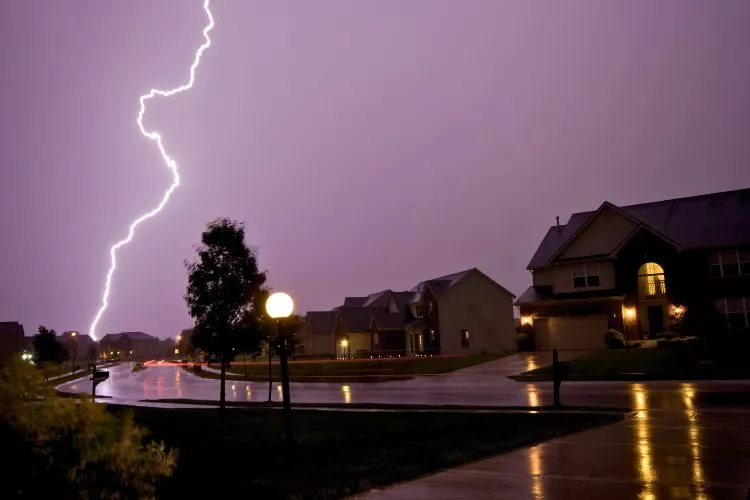
Determining the Safest Places
Indoor Buildings or Structures: The safest place to be during a lightning storm is inside a substantial, fully enclosed building. Seek shelter in a house, office, school, or other permanent structures. Avoid small sheds, open garages, and structures with roofs made of lightweight materials.
Hardtop Vehicles: If you are unable to find shelter indoors, a hardtop vehicle can provide a degree of protection. Avoid convertibles, open cabins on boats, and motorcycles. Roll up the windows and avoid touching metal surfaces inside the vehicle.
Low-Lying Areas: If you are caught in an open area during a lightning storm with no nearby buildings or vehicles, seek low-lying areas away from tall objects. Find a depression or a valley, but avoid areas prone to flooding.
Avoid High Ground and Isolated Trees: During a lightning storm, tall objects, including trees, can become lightning targets. Stay away from isolated trees, hilltops, ridges, and areas with open fields. Seek shelter in lower areas.
Safety Tips for Outdoor Activities
Stay Informed
Check weather forecasts before venturing outdoors. Stay updated on the likelihood of thunderstorms and plan activities accordingly to avoid being caught in dangerous situations.
Lightning Safety Protocol
Follow the “30-30 Rule.” If you see lightning and hear thunder within 30 seconds, seek shelter immediately. Wait at least 30 minutes after the last thunderclap before resuming outdoor activities.
Monitor Local Conditions
Pay attention to the sky and notice signs of an approaching thunderstorm, such as dark, towering clouds, distant thunder, or sudden changes in wind direction. Be prepared to take shelter promptly.
Safety in Open Spaces
If you are participating in outdoor activities like hiking, camping, or sports, ensure there are nearby lightning-safe shelters available. Plan your itinerary accordingly, avoiding areas far from safety.
Avoid Conductive Objects
Stay away from objects that conduct electricity, such as metal fences, power lines, water bodies, and objects made of metal. Seek shelter in fully enclosed structures instead.
During a lightning storm, the safest place to be is inside a substantial, fully enclosed building. If that’s not an option, seek shelter in a hardtop vehicle or a low-lying area away from tall objects.
Avoid high ground, isolated trees, and open spaces. Stay informed about weather conditions, follow lightning safety protocols, and be aware of your surroundings.
Minimizing the risks of being struck by lightning while outdoors requires vigilance and making safe choices. Always prioritize personal safety during thunderstorms, and remember that no outdoor activity is worth risking your life.
Frequently Asked Questions (FAQs)
Can a gazebo provide sufficient shelter during lightning storms?
While a hardtop gazebo made of solid materials can offer some protection during thunderstorms, seeking shelter indoors is still the safest option.
What are the best materials for lightning-resistant gazebos?
Materials like wood, especially if uninsulated by metal components, can offer better insulation against lightning strikes compared to metal gazebos. However, grounding is essential for both types of gazebos.
Is grounding a gazebo essential for safety during thunderstorms?
Yes, properly grounding a gazebo reduces the risk of electrical shock and potential damage from lightning strikes. Consult a professional electrician to ensure proper grounding.
Are there any additional safety measures to consider when using a gazebo in lightning-prone areas?
In lightning-prone areas, it is important to keep an eye on weather forecasts and establish an emergency action plan. Knowing the location of nearby indoor shelters and having a lightning safety protocol in place are essential.
Choosing the Right Gazebo for Lightning Safety
When selecting a gazebo for use in areas prone to thunderstorms, it’s important to consider both the materials and design to minimize the risks of lightning strikes.
Materials to Consider
As mentioned, metal gazebos are more conductive, increasing the likelihood of attracting a lightning strike. If you live in a region that frequently experiences thunderstorms, opting for a gazebo constructed from non-metallic materials like wood, plastic, or vinyl is a better choice.
These materials provide insulation and will not conduct electricity if struck by lightning.
Wooden gazebos, when properly maintained, offer better protection against lightning than metal ones. However, it is essential that the wood is free of metal components, such as nails or screws, which could increase conductivity.
For added safety, ensuring the wooden structure is grounded can further reduce the risk of electrical shock.
Gazebo Design
The design of your gazebo also plays a significant role in its safety during thunderstorms. For example, gazebos with open sides are more vulnerable to being struck by lightning, as they lack the protection that solid walls or roofs provide.
Gazebos with hardtop roofs made of materials like shingles, metal, or solid polycarbonate can offer some degree of protection from lightning, but they must still be treated with caution during extreme weather events.
Maintenance and Inspection
Regular maintenance is crucial for ensuring the longevity and safety of your gazebo. Check for signs of wear and tear, especially in areas where metal components may have rusted or wood may have deteriorated.
Proper maintenance not only extends the life of the gazebo but also reduces the risks of lightning damage by ensuring that the structure remains sound and properly grounded.
Conclusion:
While gazebos can enhance outdoor experiences and provide shelter during various weather conditions, it is essential to prioritize safety during thunderstorms.
Understanding the risks associated with lightning strikes and taking necessary precautions, such as seeking proper shelter and grounding gazebos, can help mitigate potential dangers.
Always prioritize personal safety and make informed decisions when it comes to enjoying outdoor activities during thunderstorms.

Sergio Gomes, a passionate advocate for outdoor living and the male voice behind Shades Authority. With years of experience, Sergio is your trusted source for expert insights on gazebos, pavilions, cabanas, pergolas, and all things outdoor shade solutions. Join him on a journey to transform your outdoor spaces into stunning, functional retreats
